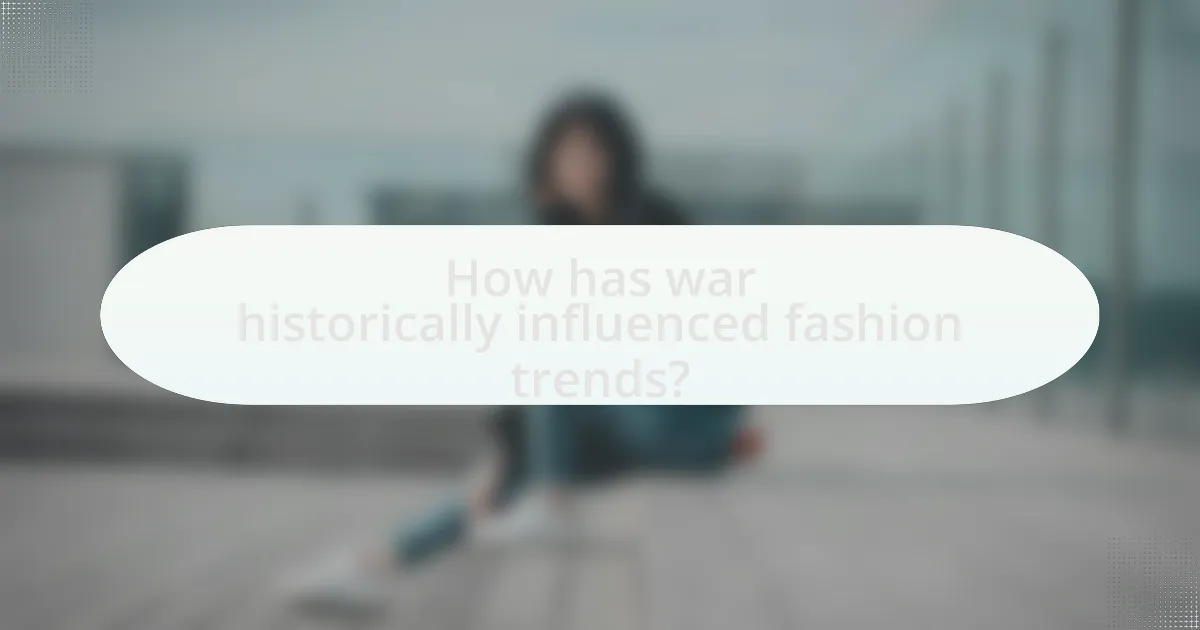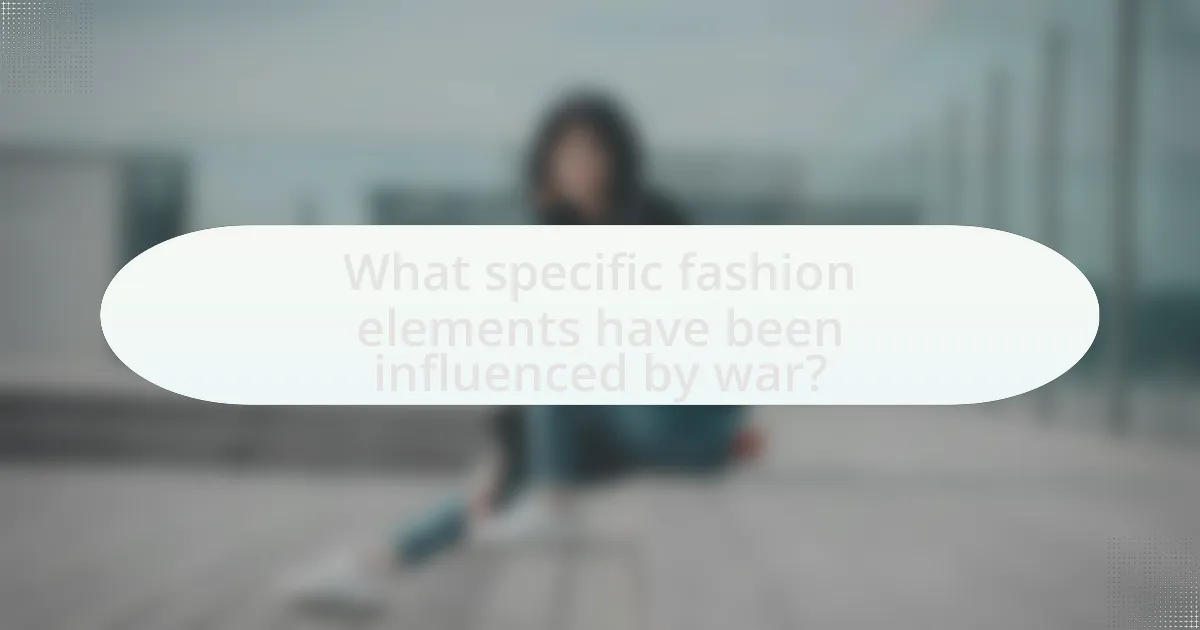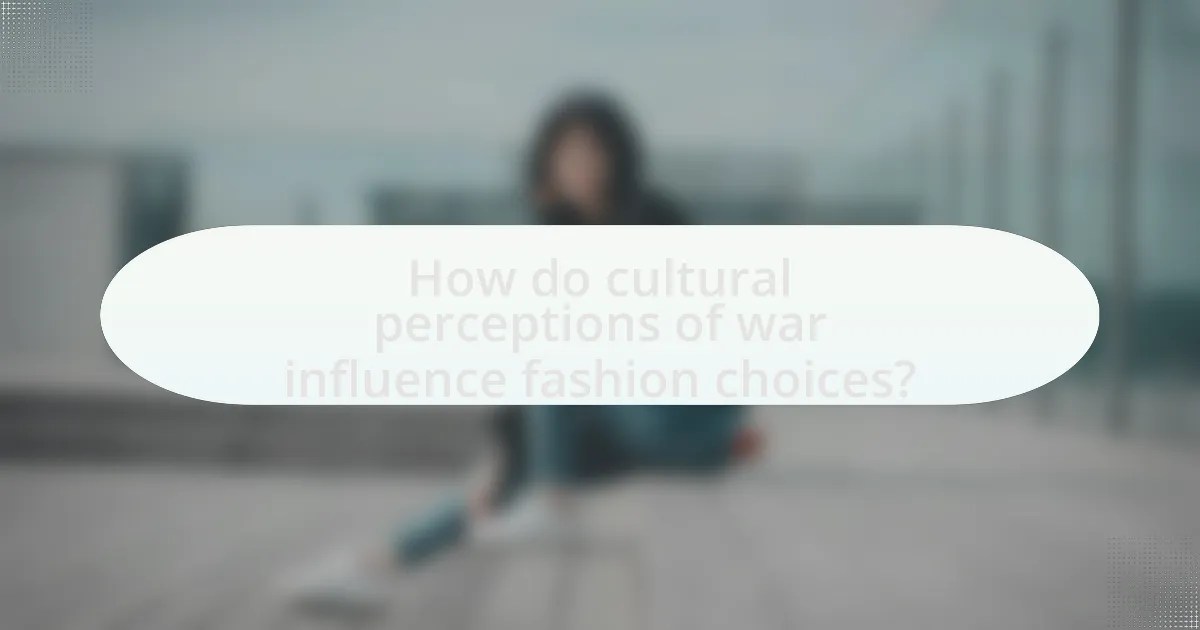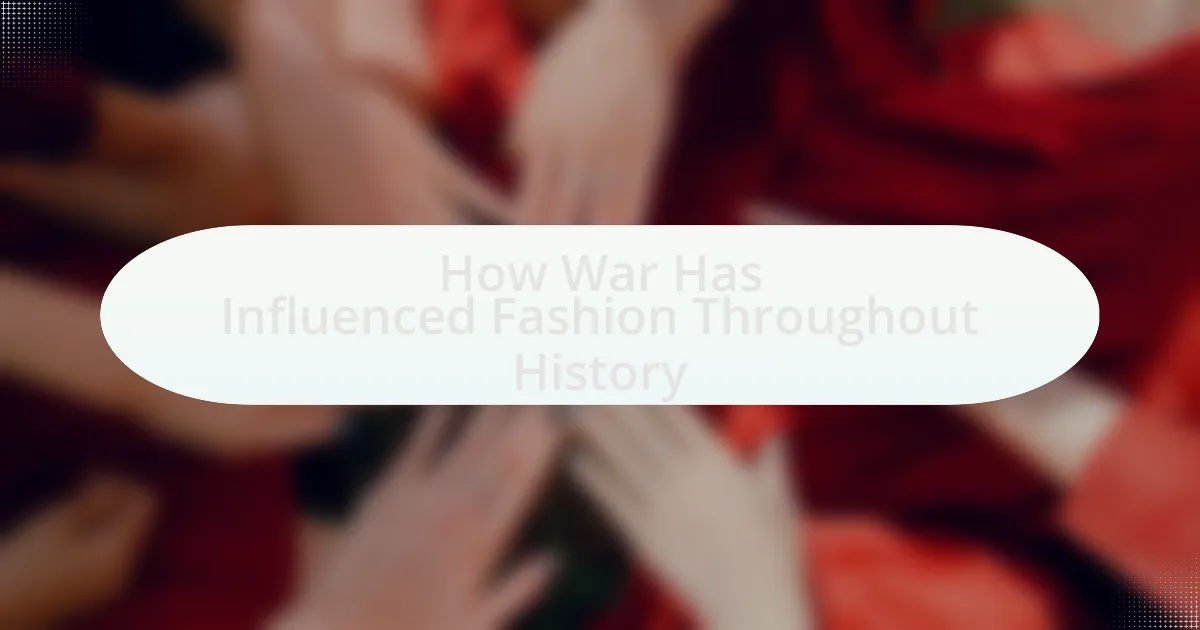The article examines the historical influence of war on fashion trends, highlighting key periods such as the Napoleonic Wars, World War I, and World War II. It discusses how conflicts have driven changes in materials, styles, and societal roles, leading to the adoption of utilitarian designs and military-inspired garments in civilian fashion. The article also explores the impact of wartime rationing on fabric choices, innovations in textile technology, and the psychological effects of war on fashion trends, illustrating how societal attitudes towards conflict shape clothing choices and design. Additionally, it addresses how contemporary designers draw inspiration from wartime aesthetics while balancing historical references with modern styles.

How has war historically influenced fashion trends?
War has historically influenced fashion trends by driving changes in materials, styles, and societal roles. For instance, during World War I, the need for practical clothing led to the adoption of more utilitarian designs, such as the trench coat, which became a staple in men’s fashion. Additionally, the fabric rationing during the war prompted innovations in textile production, leading to the use of synthetic materials like rayon. Furthermore, World War II saw women entering the workforce in unprecedented numbers, which resulted in the popularization of more functional and masculine styles for women, such as trousers and tailored suits. These shifts not only reflected the immediate needs of wartime but also had lasting impacts on post-war fashion, as the styles and materials introduced during these periods continued to influence designers and consumers long after the conflicts ended.
What are the key historical periods where war impacted fashion?
Key historical periods where war impacted fashion include the Napoleonic Wars (1803-1815), World War I (1914-1918), and World War II (1939-1945). During the Napoleonic Wars, military uniforms influenced civilian clothing, leading to the adoption of tailored silhouettes and the use of epaulettes. In World War I, the need for practicality resulted in the popularity of more functional garments, such as the trench coat and shorter hemlines for women, reflecting a shift towards utilitarian fashion. World War II further accelerated changes, with fabric rationing prompting innovative designs and the emergence of styles like the “New Look” in the post-war era, which emphasized femininity and luxury after years of austerity. These periods illustrate how warfare directly shaped fashion trends and societal norms.
How did the Napoleonic Wars shape military and civilian attire?
The Napoleonic Wars significantly influenced military and civilian attire by introducing structured uniforms and adopting elements of military style into everyday fashion. Military uniforms became more standardized, featuring tailored cuts, epaulettes, and distinctive insignia, which emphasized discipline and national identity. This military influence permeated civilian clothing, leading to the adoption of high collars, fitted silhouettes, and the use of bold colors, reflecting the styles seen in military garb. The popularity of the military aesthetic in civilian life was further reinforced by the romanticization of soldiers and their attire in art and literature during and after the wars, solidifying the connection between military and civilian fashion.
What fashion changes occurred during World War I?
Fashion changes during World War I included a shift towards practicality and functionality in clothing. As women entered the workforce in greater numbers, they adopted more utilitarian styles, such as shorter skirts and tailored suits, which allowed for ease of movement. The war also led to the introduction of military-inspired garments, including trench coats and khaki colors, reflecting the influence of military uniforms on civilian attire. Additionally, the scarcity of materials due to wartime rationing resulted in simpler designs and the use of alternative fabrics. These changes marked a significant departure from the elaborate fashions of the pre-war era, emphasizing comfort and practicality over ornamentation.
How did World War II influence post-war fashion styles?
World War II significantly influenced post-war fashion styles by introducing practicality and functionality into women’s clothing, reflecting the societal changes of the time. During the war, fabric rationing led to simpler designs and the use of more durable materials, which persisted in the post-war era. For instance, the popularity of the “New Look” by Christian Dior in 1947, characterized by a cinched waist and full skirt, marked a shift towards femininity after years of utilitarian styles. This change was a response to the desire for luxury and glamour in the aftermath of the war, as well as a reflection of women’s evolving roles in society, where they had taken on jobs traditionally held by men. The integration of military-inspired elements, such as structured silhouettes and bold colors, also became prevalent, showcasing the lasting impact of wartime aesthetics on civilian fashion.
Why do wars lead to changes in fashion?
Wars lead to changes in fashion primarily due to shifts in societal roles, economic conditions, and cultural influences that arise during and after conflicts. For instance, World War I saw women entering the workforce in unprecedented numbers, leading to the adoption of more practical clothing styles, such as shorter skirts and tailored suits, which reflected their new roles. Additionally, wartime shortages often resulted in the use of alternative materials and simpler designs, as seen in the rationing of fabrics during World War II, which led to the popularity of utility clothing in Britain. These changes illustrate how the demands of war can reshape fashion trends, making them more functional and reflective of the evolving social landscape.
How do resource scarcity and innovation during war affect clothing design?
Resource scarcity and innovation during war significantly influence clothing design by necessitating the use of alternative materials and promoting functional, utilitarian styles. During conflicts, traditional fabric sources often become limited, leading designers to explore substitutes such as synthetic fibers or repurposed materials. For example, during World War II, the U.S. government encouraged the use of nylon and other synthetic materials due to shortages of cotton and wool, resulting in the creation of practical garments like military uniforms and civilian clothing that emphasized durability and ease of production. This shift not only addressed immediate needs but also paved the way for post-war fashion trends that embraced these innovations, demonstrating how wartime conditions can reshape the clothing industry and consumer preferences.
What role does propaganda play in shaping fashion during conflicts?
Propaganda plays a significant role in shaping fashion during conflicts by influencing public perception and morale. During wartime, governments often use fashion as a tool to promote national identity and unity, encouraging citizens to adopt styles that reflect patriotism. For instance, during World War II, the U.S. government promoted utility clothing to conserve resources, which not only aligned with wartime needs but also fostered a sense of collective sacrifice and support for the war effort. This was evident in the “Make Do and Mend” campaign, which encouraged individuals to repurpose existing clothing, thereby reinforcing the idea of resilience and national solidarity. Such initiatives demonstrate how propaganda can directly impact fashion choices, aligning them with broader political and social objectives during conflicts.

What specific fashion elements have been influenced by war?
Military uniforms have significantly influenced fashion elements, including the adoption of utilitarian styles, structured silhouettes, and specific fabrics. For instance, the trench coat emerged from World War I military attire, designed for practicality and protection against the elements. Additionally, camouflage patterns, initially developed for military use, have been integrated into civilian clothing, reflecting a blend of functionality and style. The use of khaki and olive drab colors in everyday fashion can also be traced back to military influences, showcasing how wartime needs have shaped contemporary clothing trends.
How have military uniforms influenced civilian fashion?
Military uniforms have significantly influenced civilian fashion by introducing elements such as structured silhouettes, functional designs, and specific color palettes. For instance, the adoption of khaki and camouflage patterns in everyday clothing emerged from military attire, particularly during World War I and II, when soldiers wore these colors for practicality. Additionally, the tailored cuts and epaulettes seen in military uniforms have inspired tailored suits and outerwear in civilian wardrobes, reflecting a blend of authority and style. Historical examples include the popularity of the trench coat, originally designed for soldiers, which became a staple in civilian fashion post-war. This influence is evident in contemporary fashion, where military-inspired pieces frequently appear on runways and in streetwear, demonstrating the lasting impact of military aesthetics on civilian clothing choices.
What are the key features of military-inspired fashion trends?
Military-inspired fashion trends are characterized by utilitarian designs, camouflage patterns, and structured silhouettes. These features reflect the practical and functional aspects of military uniforms, emphasizing durability and versatility. Utilitarian designs often include cargo pockets, epaulets, and reinforced stitching, which are practical elements derived from actual military attire. Camouflage patterns, originally developed for concealment in combat, have been adapted into mainstream fashion, symbolizing a rugged aesthetic. Structured silhouettes, often seen in tailored jackets and fitted trousers, convey authority and strength, mirroring the disciplined appearance of military personnel. These elements collectively highlight the influence of military aesthetics on contemporary fashion, demonstrating a blend of functionality and style.
How have specific military garments transitioned into mainstream fashion?
Specific military garments have transitioned into mainstream fashion through a combination of cultural influence, practicality, and aesthetic appeal. For example, items like bomber jackets, cargo pants, and camouflage patterns have been adopted by civilian populations due to their functionality and style. The bomber jacket, originally designed for pilots in World War II, became a fashion staple in the 1980s, symbolizing rebellion and youth culture. Similarly, cargo pants, initially created for military use, gained popularity in the 1990s for their practicality and comfort, becoming a common choice in casual wear. Camouflage patterns, once exclusive to military uniforms, have been embraced in streetwear and high fashion, reflecting a blend of utility and trendiness. This transition is supported by the cyclical nature of fashion, where historical references are frequently reinterpreted, allowing military garments to maintain relevance in contemporary style.
What materials and technologies have emerged from wartime fashion needs?
Wartime fashion needs have led to the emergence of materials such as nylon, polyester, and advancements in synthetic fabrics. During World War II, nylon was developed as a substitute for silk, primarily for parachutes, and later became widely used in hosiery and other garments. Polyester emerged in the 1950s, offering durability and wrinkle resistance, which appealed to both military and civilian clothing markets. Additionally, technologies such as mass production techniques and the use of camouflage patterns were refined during wartime, influencing fashion design and manufacturing processes. These innovations not only addressed immediate wartime requirements but also shaped post-war fashion trends and consumer preferences.
How did wartime rationing affect fabric choices and clothing styles?
Wartime rationing significantly restricted fabric choices and influenced clothing styles by prioritizing utility over fashion. During World War II, governments imposed strict limits on the types and quantities of materials available for civilian clothing, leading to the use of synthetic fabrics and less expensive materials like rayon instead of luxury textiles such as silk and wool. This shift resulted in simpler, more functional designs, as seen in the popularity of the “make do and mend” ethos, which encouraged people to repair and repurpose existing garments rather than buy new ones. Historical evidence shows that the U.S. War Production Board regulated clothing production, enforcing guidelines that limited the amount of fabric used in garments, which directly shaped the streamlined silhouettes and practical styles of the era.
What innovations in textile technology were driven by military needs?
Innovations in textile technology driven by military needs include the development of synthetic fibers, advanced camouflage patterns, and moisture-wicking fabrics. Synthetic fibers such as nylon and polyester were first developed during World War II to create stronger, lighter, and more durable materials for uniforms and equipment. Advanced camouflage patterns emerged to enhance concealment in various environments, significantly improving soldier safety and effectiveness. Additionally, moisture-wicking fabrics were designed to keep soldiers dry and comfortable in extreme conditions, enhancing performance and reducing the risk of heat-related illnesses. These innovations have not only transformed military apparel but have also influenced civilian fashion and textile applications.

How do cultural perceptions of war influence fashion choices?
Cultural perceptions of war significantly influence fashion choices by shaping the symbolism and aesthetics associated with military themes. For instance, during World War II, the adoption of utilitarian styles, such as the “victory rolls” hairstyle and military-inspired clothing, reflected a sense of patriotism and resilience. Additionally, the post-war era saw the emergence of fashion that romanticized military elements, as seen in the popularity of camouflage patterns and bomber jackets, which became symbols of rebellion and youth culture. Historical events, such as the Vietnam War, further impacted fashion by leading to anti-war sentiments that manifested in clothing choices like peace symbols and tie-dye patterns, representing a countercultural movement. Thus, the interplay between cultural perceptions of war and fashion choices reveals how societal attitudes towards conflict can shape trends and expressions in clothing.
What psychological effects do wars have on fashion trends?
Wars significantly influence fashion trends by altering societal values, emotional states, and cultural expressions. The psychological impact of conflict often leads to a desire for practicality and functionality in clothing, as seen during World War II when rationing necessitated simpler, more utilitarian designs. This shift can be observed in the adoption of military-inspired styles, such as bomber jackets and cargo pants, which reflect a blend of resilience and adaptability in response to the harsh realities of war. Additionally, the trauma and collective grief experienced during wartime can drive a longing for nostalgia, prompting a revival of past styles that evoke comfort and familiarity. Historical evidence shows that post-war periods often see a surge in fashion that emphasizes optimism and renewal, as exemplified by the emergence of the New Look in the late 1940s, which symbolized a return to femininity and luxury after the austerity of war.
How does the symbolism of war impact fashion statements?
The symbolism of war significantly impacts fashion statements by influencing design elements, color palettes, and cultural narratives. For instance, military uniforms have historically inspired civilian clothing, leading to the adoption of utilitarian styles and camouflage patterns in mainstream fashion. The emergence of the “military chic” trend in the late 20th century, particularly during the Gulf War, showcased how war-related aesthetics can permeate everyday attire, reflecting societal attitudes towards conflict. Additionally, designers like Balmain and Alexander Wang have incorporated military motifs, demonstrating that the symbolism of war can evoke themes of strength and resilience in fashion. This connection between war and fashion is evident in the way garments often serve as a commentary on political and social issues, reinforcing the idea that fashion is not merely about aesthetics but also about cultural significance.
What are the societal attitudes towards fashion during and after conflicts?
Societal attitudes towards fashion during and after conflicts often reflect a blend of practicality, resilience, and a desire for normalcy. During conflicts, fashion tends to prioritize functionality and durability, as seen in World War II when rationing led to simpler, more utilitarian clothing styles. After conflicts, there is typically a resurgence of creativity and expression in fashion, as societies seek to reclaim their identity and celebrate peace, exemplified by the vibrant styles of the 1920s following World War I. Historical evidence shows that post-conflict periods often inspire innovative fashion movements, as seen in the rise of haute couture in the aftermath of World War II, indicating a societal shift towards optimism and renewal.
How do contemporary designers draw inspiration from wartime fashion?
Contemporary designers draw inspiration from wartime fashion by incorporating utilitarian elements, historical silhouettes, and symbolic motifs into their collections. For instance, the use of military-inspired cuts, such as structured shoulders and tailored lines, reflects the influence of uniforms worn during conflicts. Designers like Alexander McQueen and Balenciaga have utilized camouflage patterns and military colors, which evoke a sense of resilience and strength associated with wartime attire. Additionally, the repurposing of materials, such as canvas and leather, mirrors the resourcefulness seen during wartime, where fabric shortages led to innovative designs. This connection to history not only pays homage to the past but also resonates with contemporary themes of survival and adaptation in fashion.
What are some examples of modern fashion collections influenced by war themes?
Modern fashion collections influenced by war themes include the 2014 collection by Alexander McQueen, which drew inspiration from World War I and featured military silhouettes and trench coats. Another example is the 2016 collection by Balmain, which incorporated elements reminiscent of military uniforms and combat gear, reflecting the designer’s fascination with the strength and resilience associated with wartime. Additionally, the 2018 collection by Givenchy showcased designs that echoed the aesthetics of military attire, emphasizing structured tailoring and utilitarian details. These collections illustrate how contemporary designers utilize war themes to explore concepts of power, identity, and resilience in their work.
How do designers balance historical references with modern aesthetics?
Designers balance historical references with modern aesthetics by selectively integrating elements from past styles while ensuring they resonate with contemporary trends. This approach allows designers to create pieces that honor historical significance, such as military uniforms or wartime fashion, while adapting them to current materials, silhouettes, and cultural contexts. For instance, the use of camouflage patterns in high fashion reflects military history, yet is reinterpreted through modern cuts and fabrics, making it relevant today. This method not only preserves the narrative of fashion influenced by war but also appeals to modern consumers seeking both style and meaning in their clothing choices.
What practical insights can we gain from the influence of war on fashion?
The influence of war on fashion reveals practical insights about adaptability, resourcefulness, and the reflection of societal values. During conflicts, fashion often shifts towards practicality and functionality, as seen in World War II when women adopted utilitarian clothing styles like trousers and overalls to support war efforts and workforce demands. This shift illustrates how external pressures can drive innovation in design and material use, leading to the emergence of new trends such as the popularity of military-inspired garments in civilian life. Additionally, wartime scarcity often leads to the repurposing of materials, as evidenced by the use of parachute silk in post-war fashion, demonstrating how necessity can foster creativity and sustainability in the fashion industry.
How can understanding wartime fashion trends inform current fashion design?
Understanding wartime fashion trends can inform current fashion design by highlighting the adaptability and resourcefulness required during periods of scarcity. For instance, during World War II, fabric rationing led to the creation of more functional and versatile clothing, such as the iconic utility dress, which emphasized practicality without sacrificing style. This historical context illustrates how designers can draw inspiration from past challenges to innovate contemporary designs that prioritize sustainability and functionality. Additionally, wartime fashion often reflects social changes, such as the increased presence of women in the workforce, which can guide modern designers in creating inclusive and representative collections that resonate with current societal values.
What lessons can fashion industries learn from historical wartime influences?
Fashion industries can learn the importance of adaptability and resourcefulness from historical wartime influences. During World War II, for instance, fabric rationing led to innovative designs that utilized fewer materials, such as the creation of the “utility dress” in Britain, which emphasized functionality and simplicity. This period also saw the rise of unisex clothing, as wartime labor shortages necessitated practical attire for both men and women. The success of these adaptations demonstrates that fashion can thrive under constraints by prioritizing utility and sustainability, a lesson increasingly relevant in today’s eco-conscious market.

Leave a Reply